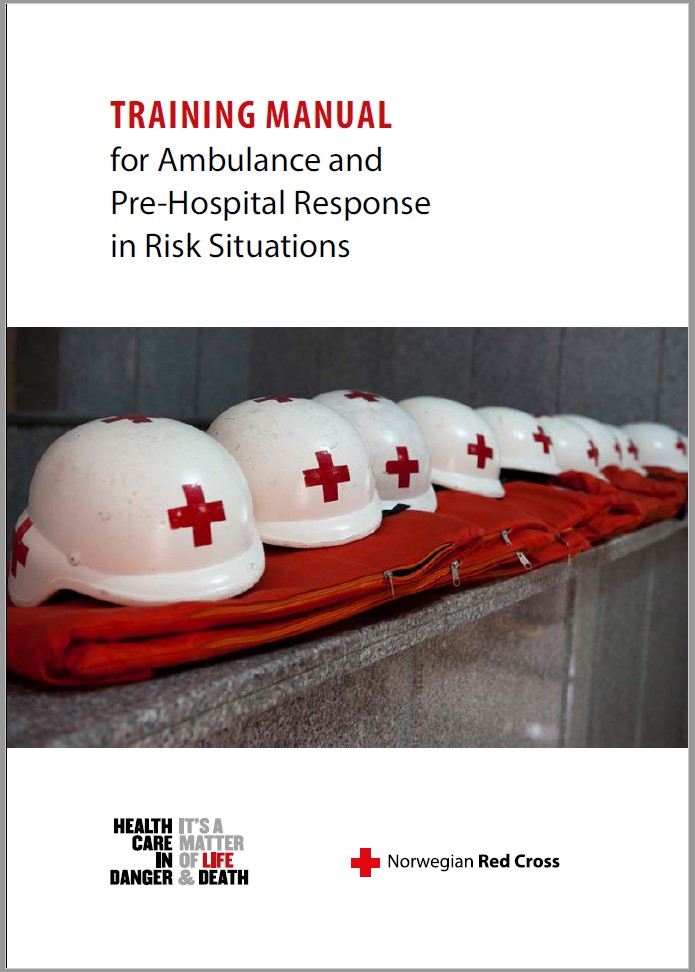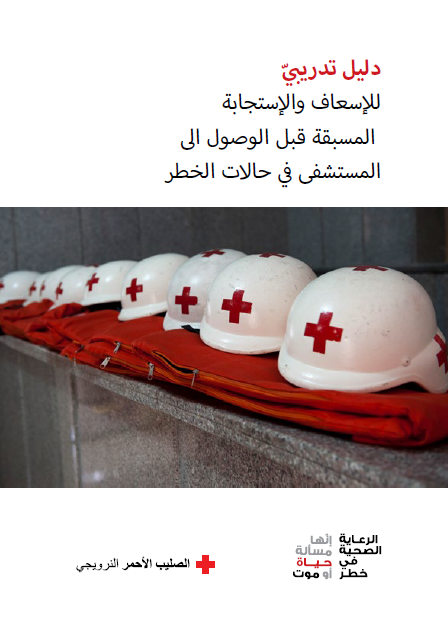Training
Training manual for ambulance and pre-hospital response in risk situations - A Pilot
A Conversation about the Training Manual for Ambulance and Pre-Hospital Response in Risk Situations (TARRS) with Karen-Anna Joval, Senior Protection Advisor – Health Care in Danger at the Norwegian Red Cross
Ms. Joval developed the TARRS training manual and answered some questions from the HCiD team in order to shed more light on the manual and process.
The Norwegian Red Cross have developed a training manual to consolidate and reinforce security management for providers of ambulance and pre-hospital services. The ICRC has provided technical inputs into the manual’s development and the Norwegian Red Cross is piloting the approach with partners in the International Red Cross and Red Crescent Movement and external health service providers.

Karen-Anna Joval
Senior Protection Advisor at Health Care in Danger at the Norwegian Red Cross
The idea of TARRS is to provide a more detailed guidance given the specificity of this work and need to respond to the concrete challenges faced by ambulance and pre-hospital service providers.
Why do we need a Training Manual for Ambulance and pre-hospital Response in Risk Situations, or “TARRS” as it is being called?
Physical assaults, verbal abuse, the denial of access to health services, and threats of violence are just a few examples of how violence is affecting ambulance and pre-hospital services. Ambulance and pre-hospital personnel are working in environments with higher security risks, particularly in armed conflict. The risks vary from context to context and providers of emergency medical services need to be better prepared to analyse and manage these risks in a secure manner.
The TARRS manual helps you reflect on how you can strengthen the security of ambulance and pre-hospital professionals, and how you can prevent and mitigate violence.
The TARRS manual focuses on risk awareness and on the conduct of emergency care providers to improve preparedness, prevent security incidents and reduce the incidence and impact of incidents during the delivery of health services. TARRS is a low-threshold initiative; through the workshop session you will develop a short set of informed and contextual recommendations that can support practical skill development in day-to-day operations to make healthcare provision safer. It provides a useful starting point for those looking to review and reinforce existing procedures to improve preparedness and security management.
Can you provide a bit of background on the impetus to develop such a training?
The idea to develop this manual is linked to the work of the Community of Action for Ambulance Pre-hospital Care Providers (CoA), established in 2016 under the auspices of the Health Care in Danger Initiative. This Community, where we in NorCross played a significant role, sought to be the first port of call for the ambulance and pre-hospital services to discuss challenges and share good practices with the overall objective to security of their services. By working with this group of experts it became apparent that guidance tailored to ambulance and pre-hospital care personnel was needed.
We found that there are existing trainings and tutorials on how to deal with and understand how violence against healthcare workers occurs. What was lacking is identifying a more complete set of clear, implementable actions to prevent and reduce violence against medical first responders.
TARRS is built around a workshop employing a wide range of training methods, including reflections, active discussions, role plays, individual and group activities. These different approaches generate an accurate picture of the context and current practices and recommendations for further action.
What is new in this approach and how does it relate to other reference documents and trainings?
What is new about this approach is the individual and active role that each individual has in reducing threats and violence against themselves and the service. TARRS is meant to be complementary to other approaches and tools. This process is largely informed by the Ambulance and Pre-Hospital Services in Risk Situations report, which is a collection of lessons learnt from twelve Red Cross and Red Crescent National Societies with extensive operational experience in the ambulance and pre-hospital sector. This report provides you with insights and inspiration on how to address challenges.
Other key approaches and tools that have shaped this approach include the Safer Access Framework, the Best Practice for Ambulance Services in Risk Situations and the Training Manual on Interpersonal Violence Prevention and Stress Management in Health Facilities.
The idea of TARRS is to provide a more detailed guidance given the specificity of this work and need to respond to the concrete challenges faced by ambulance and pre-hospital service providers.
What happens next with the recommendations produced through the workshop?
Recommendations are reviewed by National Society management and partners and a follow up Plan of Action should be devised to integrate recommendations into existing processes and approaches, including risk management procedures. If further training and specific support are required, this should be determined and a collective strategy devised to support implementation.
What are the conditions for the TARRS approach to be successful?
To name a few: each context must be treated as unique and dynamic and the approach to TARRS tailored to the context. Recommendations need to be aligned with and built into existing active security management processes. The support of management is critical for TARRS to succeed, including prior to any implementation. This ensures that the recommendations are systemically integrated into the NS’s approach to risk assessment and management in relation to ambulance and pre-hospital care.
Ultimately, the extent to which following up on recommendations is feasible will vary from one context to another. The TARRS process will nonetheless provide valuable knowledge on how to reduce risk and make the scene safer for you and your colleagues. Clearly, the more you put into the process, the more valuable it will be.
Who should use TARRS?
This manual is designed for ambulance and pre-hospital personnel and to provide an opportunity to be better prepared when exposed to perilous situations. It should be facilitated by staff who have been trained in TARRS. TARRS is highly relevant for National Societies of the International Red Cross and Red Crescent Movement.
How should the TARRS manual be used?
These guidelines provide an overall conceptual and methodological approach to help ambulance and prehospital personnel to increase their resilience towards a series of risks they are faced with in the frame of their activities. The manual is not a prescriptive how-to guide but rather a theoretical guidance with operational examples. It cannot be fully prescriptive; because it applies broadly to many contexts and scenarios, all the information it contains will have to be adapted in view of local needs.
If I am interested to use the TARRS training manual, can I contact you?
Yes, by all means. I can be reached at anna.joval@redcross.no

The Manual
The training Manual for Ambulance and Pre-Hospital Response in Risk Situations, or “TARRS” builds on the work under the Health Care in Danger Initiative and emerged out of the work of the Community of Action for Ambulance Pre-hospital Care Providers (CoA), established in 2016.
TARRS aims to provide ambulance and pre-hospital personnel with an opportunity to be better prepared when exposed to perilous situations. It is designed to be user friendly, and relevant for ambulance providers in operational services worldwide. It should be implemented based on an assessment of the context in which the ambulance providers operate, and of the current standard operating procedures that the ambulance service follows to mitigate risk. It focuses on individual protective behaviour and highlights the active role responders can play in reducing the incidence of violence and threats. Ambulance providers are encouraged to contribute their experiences and knowledge while using the training manual.
